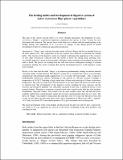| dc.description.abstract | The goal of the current research effort is to revive through aquaculture, the population of Labeo
victorianus (“Ningu”), a previously important commercial fish species of Lake Victoria but now
threatened with extinction. The specific focus of the study was to obtain sufficient understanding of the
feeding biology and adaptations of L. victorianus to changes in diet during growth to enable
development of diets for commercial aquaculture production.
Specimens of “Ningu” were collected from the mouths of Rivers Kagera and Sio on monthly basis for
an entire annual cycle. The composition of the gut contents were analysed to determine the feeding
habits. The structure of the digestive system was studied to determine the adaptations of the system to
its diet. Ripe broodstocks collected from the mouth of River Sio during peak spawning were
successfully induced to spawn in station ponds at Kajjansi using a hormone and incubated in pond and
tanks to hatch. The process of weaning from the yolk food reserve (endogenous feeding) to external
(exogenous) feeding, the starter (weaning) diet and the development process of the digestive system
were recorded. Results so far show that the adult “Ningu” is an omnivore predominantly feeding on detritus material
consisting mainly of plant material. The digestive system has no stomach and consists of an extremely
elongated gut with intestinal length ranging from 7 to 11.8 times the body length. This is typical of
predominantly herbivorous animals. Spawning of fish induced at 5.00 pm occurred overnight at
temperatures of 19-20 oC. Hatching of eggs started after 10 hours and lasted up to 18 hours at the above
temperatures. The yolk sac food reserve lasted from five to six days before the larvae were able to take
in external food. The development of the digestive system, including the liver, pancreas and the
secretary and absorptive epithelia, was sufficiently advanced by day four to enable the larvae to start
external feeding. Weaning to exogenous (external) food source started on the fifth day after hatching.
Zooplankton, especially rotifers, were found to be the most suitable starter diet and then the larvae
gradually shifted from a predominantly animal diet towards a predominantly plant diet as it grew. The
larvae of “Ningu” were unable to utilize plant diet until they were two weeks old. The larvae were able
to take in and utilise dry diet from three weeks and a formulation of Maize bran (40%), “mukene”
33%), baby soya food (25%) and mineral premixes (2%) gave reasonable survival and growth.
The quick development of the swim bladder and the pectoral fin after one and two days, respectively,
was found to be very important for survival of the larvae, facilitating escape from predators and
searching for food. | en_US |

